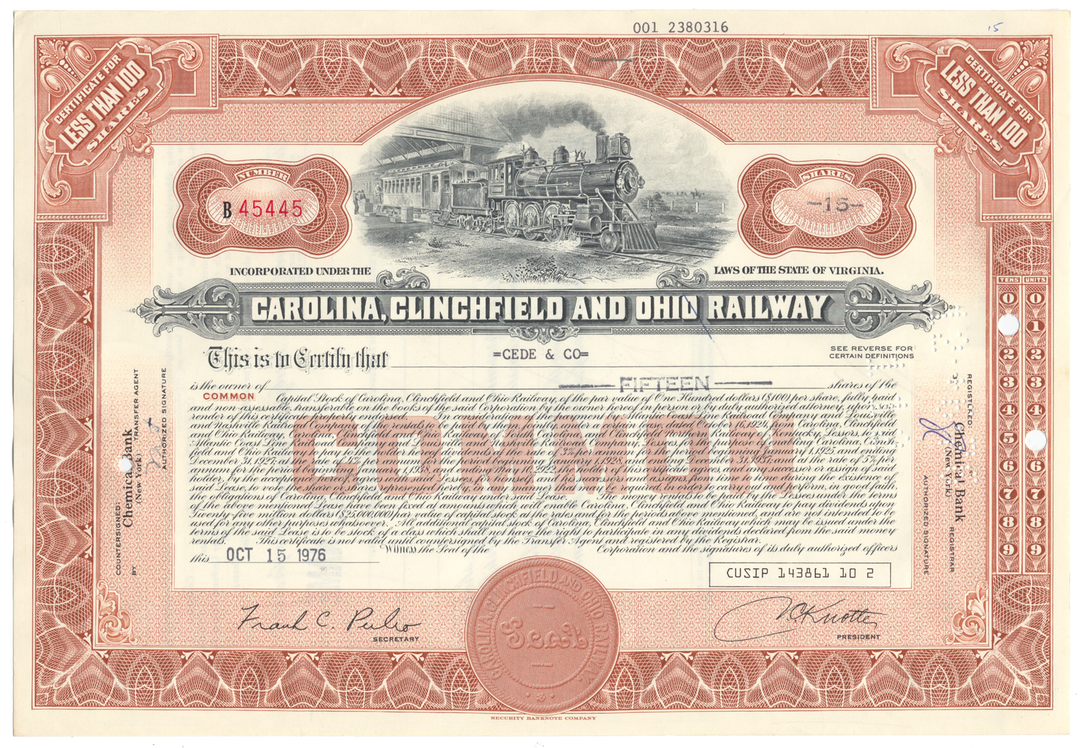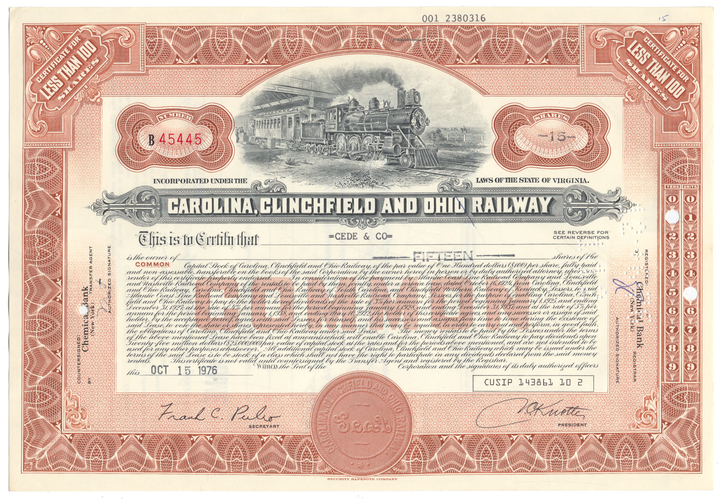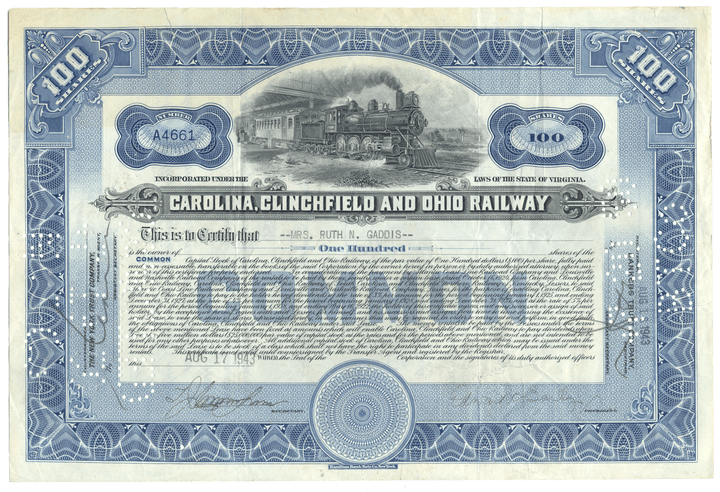Carolina, Clinchfield and Ohio Railway
- Guaranteed authentic document
- Orders over $75 ship FREE to U. S. addresses
Product Details



Certificate Type
Common Stock
Date Issued
October 15, 1976 (rust)
August 17, 1943 (blue)
Canceled
Yes
Printer
Security Bank Note Company (rust)
Hamilton Bank Note (blue)
Signatures
Machine printed (rust)
Hand signed (blue)
Approximate Size
12 1/4" (w) by 8" (h)
Additional Details
NA
Historical Context

The Carolina, Clinchfield and Ohio Railway (CC&O) was built as a 277 mile bridge route across two mountain ranges operating in five states: Kentucky, Virginia, Tennessee, North Carolina, and South Carolina. George L. Carter, known as the "Father" of the modern day Clinchfield, organized the CC&O Railway in March 1908 from four existing short railroads, several charters, and failed efforts. His vision was to build a connection from the port of Charleston, South Carolina through the coal fields of Virginia and Kentucky to the markets of Cincinnati and the Ohio River. Carter commissioned M. J. Caples from the Norfolk and Western Railway to engineer a route for heavy coal hauling and merchandise traffic across the Blue Ridge Mountains. Caples result was a railroad designed to very high standards for the time. Actual maximum grades were kept at 1.5% against Southbound traffic through the Breaks of the Big Sandy River, 1.2% up the Blue Ridge climb Northbound, and less than a mile of 1.8% Northbound grade at Sandy Ridge. Maximum curves of 14 degrees were not exceeded, while most were 10 degrees or less in 20 degree country. Scientific American called it the costliest railroad to cross the Appalachian Blue Ridge mountains. The modern day CC&O has existed almost as built with few re-alignments to haul record tonnage and make record profits for almost ninety years.
A link with the Chesapeake & Ohio Railroad was made upon the completion of the building of the Elkhorn Extension from Dante, to Elkhorn City. Carter drove the ceremonial golden spike to link the line south of Dante with the C&O and to complete the railroad's mainline on February 9th, 1915. This connection was vital in making the Clinchfield an important part of the National railway map. The CC&O, with its southern terminus at Spartanburg, SC, quickly became a serious bridge route for merchandise traffic from the Midwest to Southeastern markets.
The Clinchfield had several other major traffic interchanges along its route. It interchanged with the Norfolk & Western (and Louisville & Nashville from 1973-1986) at St Paul, VA and Kiser, VA; the Interstate (Southern after 1960)-transporting mostly L&N coal, at Miller Yard, VA; the Southern at Speers Ferry, VA, Frisco, Kingsport, and Johnson City, TN, Marion, NC, and Spartanburg, SC; the Seaboard Air Line at Bostic, NC, and the Atlantic Coast Line Railroad at Spartanburg. In addition, several smaller roads like the Piedmont and Northern and Charleston & Western Carolina interchanged along the route.
In 1924, the ICC approved an agreement for the Atlantic Coast Line and Louisville and Nashville railroads to lease the CC&O for a period of 999 years. The operating company from this lease, called the Clinchfield Railroad Company, conducted a highly profitable business until December 31, 1982, when the CSX Corporation bought all shares of the CC&O and retired them. In 1974, Clinchfield, L&N, SCL, Georgia and West Point Railroads began marketing their collective transportation as the Family Lines System to compete with rival Southern Railway. Despite common paint schemes, common locomotive purchases, and pooling of motive power, the Clinchfield maintained itself as a separate entity until the merger into the Seaboard System in December 1982. Again in 1986, the Seaboard System was merged into the Chessie System to become CSX Transportation, which owns and operates the original Carolina Clinchfield and Ohio Railway today.
Related Collections
Additional Information
Certificates carry no value on any of today's financial indexes and no transfer of ownership is implied. All items offered are collectible in nature only. So, you can frame them, but you can't cash them in!
All of our pieces are original - we do not sell reproductions. If you ever find out that one of our pieces is not authentic, you may return it for a full refund of the purchase price and any associated shipping charges.










